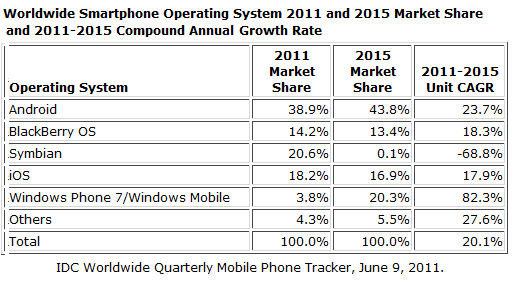IDC starts walking down Windows Phone 7 2015 projections

IDC is projecting that there will be nearly 1 billion smartphone unit shipped in 2015 and has begun the long tweaking process for its platform standings.
The research firm's quarterly smartphone prognostications include the following:
- 472 million smartphones shipped in 2011, up from 305 million in 2010;
- A landscape where Android is the top dog with 40 percent of the market in the second half of 2011;
- Continued losses for Symbian;
- Volume gains for Apple iOS and the BlackBerry OS, but market share losses.
However, the most debatable IDC projections revolve around the 2015 view. As noted previously, IDC is projecting the Nokia transition to Windows Phone 7 to go smoothly and that Microsoft will have 20 percent of the mobile platform market.
I argued that IDC's figures for 2015 were bunk and questioned Gartner's take too. Recent events---profit warnings at both Nokia and RIM---make projecting out to 2015 a fool's errand.
Fortunately, IDC is backing off a bit on its Windows Phone 7 optimism. A quarter ago, IDC's Windows Phone 7 2015 market share projection was 20.9 percent. As of Thursday, IDC is at 20.3 percent.
Anyone want to bet that IDC's 2015 projection will be a smidge below 20 percent next quarter? The wild card will be Nokia's market share going into 2012. Today Nokia looks like it is unraveling.
IDC's rationale looks like this:
Until Nokia begins introducing Windows Phone-powered smartphones in large volumes in 2012, Windows Phone 7/Windows Mobile will only capture a small share of the market as the release of Mango-powered smartphones are not expected to reach the market until late 2011. Nevertheless, assuming that Nokia's transition to Windows Phone goes smoothly, the OS is expected to defend a number 2 rank and more than 20% share in 2015.
That assumption today looks crazier than it did just three months ago.
